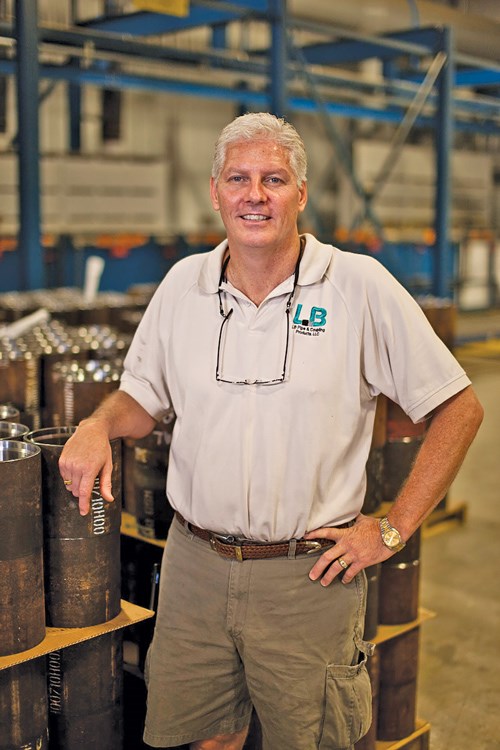Low Foam Technology Solves Production Problems
QualiChem brought in its Xtreme Cut 250C coolant to get rid of a foaming issue in a coolant delivery system.
Coolant selection can make a big difference in how equipment operates. Just ask Jim Legg, general manager of LB Pipe & Coupling, Magnolia, Texas. LB Pipe had purchased and installed an automated cell from Okuma, which was the centerpiece of a new facility for automating the production of API couplings. The cell included a pair of Okuma 2SP-V60 machines with a ChipBlaster high-pressure coolant delivery system and a high-speed robotic arm.
At the initial machine startup, shaving cream-like foam billowed out of the machine and onto the floor, shutting down the high pressure pumps and creating a maintenance and safety nightmare.
“We were not able to make one part,” Mr. Legg says. “Even when operating at 500 psi—half the recommended pressure for the machine—the foaming was so severe that we had to keep a pallet of liquid absorbent on hand to capture the coolant that spilled onto the floor.”
According to Greg Antoun, president of ChipBlaster, a manufacturer of high-pressure coolant delivery systems, “When coolant foams, it entrains air bubbles, and the density of the coolant drops dramatically. Because the foam itself is so much lighter than water-based coolant, it can’t exert the force required to make high pressure work. Foam doesn’t cool the part or lubricate the tool effectively. For practical purposes, water-based coolant is not compressible, so when coolant foams, the air bubbles are compressible, and it can’t be effectively pumped at all. It’s like trying to hammer a nail with a sponge.
Total Production Shutdown
The situation at LB Pipe got worse before it got better. When running at 500 psi, there was not sufficient pressure to keep the cutting area free of metal chips. As metal chips accumulated in the chuck, the robotic arm could not safely engage and grab the finished part. The company had to shut down production frequently to clean out chips manually and wait for the foam to dissipate.
LB Pipe’s multi-million dollar investment in new technology was beginning to look like a disaster. “The foaming coolant caused a total shutdown of production with this equipment,” Mr. Legg says. “We couldn’t use the machine unless we could get rid of the foam.”
Foaming coolant causes increased downtime, longer cycle times, more part rejections and increased coolant usage. In addition, the slip-fall potential with foam on the factory floor is a safety hazard and adds to increased disposal costs.
The original coolant supplier recommended adding defoamer. When first added to the tank, it seemed to help, but within 2 hours the foaming was as bad as ever.
Okuma called in experts that included ChipBlaster and several tooling manufacturers. Together, they spent many hours working around the clock with LB Pipe’s engineering team and operators to find the solution.
Finally, Mr. Antoun suggested they bring in an expert from QualiChem, a manufacturer of metalworking fluids. “We see lots of foaming, and I was very confident in recommending QualiChem because its products had never failed to solve any of the foaming issues we had encountered in the past.”
Proper Coolant Selection
A call was made to Jerry Peck, executive sales engineer for QualiChem, who drove 300 miles through the night to arrive on site the next morning. He assessed the situation and recommended Xtreme Cut 250C, a premium, heavy duty, semi-synthetic coolant formulated specifically to optimize tool life and surface finish in high pressure applications.
They charged one of the ChipBlaster machines with the QualiChem coolant and started up the production line. They were immediately able to begin increasing the pressure.
After 7 hours of production at 1,000 psi, the machine running on QualiChem had no foam and no chip buildup. The other machine, running at 500 psi with the previous coolant, was overflowing with foam, and chips were still accumulating inside the chuck. The decision was made to immediately clean out the second machine and recharge with the QualiChem coolant.
“The difference is dramatic. Coolant is no longer a problem with the high pressure coolant equipment. Foaming and chip accumulation have been totally eliminated,” Mr. Antoun says.
Unbelievable Results
“The report back from Mr. Legg was almost unbelievable,” says Rick Kimmins of Okuma. “The result of changing coolant made a night-and-day difference in terms of better chip control and decreased downtime. LB Pipe was able to immediately run production at the machine’s full design capacity, which also improved tool life by 300 percent.
“Shortly afterward, we invited QualiChem, as a metalworking fluid manufacturer, to join the select group of experts in our Partners in Thinc program. This allows us to leverage their expertise and knowledge to solve coolant problems experienced by our customers,” Mr. Kimmins says.
Glenn Frank, president of QualiChem, says his company has developed the Xtreme Cut 250C coolant technology to address the root cause of foam, which results in coolants that do not rely on defoamers as a band aid. QualiChem’s new coolant technology is said to result in a premium line of cutting and grinding fluids that can run at or above 1,000 psi in deionized water without foam.
"This experience taught me an important lesson,” Mr. Legg says. “When purchasing coolant, most people look at the price and buy the least expensive product available. I’ve learned it’s worth the money to use a quality coolant in terms of long-term savings.”
The key to mitigating foam in high-pressure applications is selecting the right coolant in the first place.
Mr. Antoun echoed the same feeling. “There’s an education gap in the metalworking marketplace. It’s important for companies to understand that the coolant really does matter, especially as more manufacturers are moving to high pressure applications.”
To contact LB Pipe & Coupling, visit lbpipeandcouplingproducts.com.
Related Content
Automate Coolant Management, Collect Data to Optimize Machining Operations
The future of coolant management lies in better control through automation and applying real-time data analysis and insights.
Read MoreThe Case for Higher-Performing Metalworking Fluids
Machine shops have the opportunity to enhance their profitability by choosing the proper metalworking fluids for each machining application.
Read MoreHennig Inc. Acquires Industrial Coolant Systems
ICS develops and field tests high-pressure coolant systems, coolant filtration systems and other machine tool solutions.
Read MoreBio-Air Tool Lubricants Eliminate Reportable Incidents, Cleanup Costs
These air tool oils provide excellent lubrication for both rotary and reciprocating types of air tools, such as chipping hammers, impact wrenches, air motors, grinders, reamers, drills and more.
Read MoreRead Next
Seeing Automated Workpiece Measurement in Real Time
User-friendly inspection software for CNC machining centers was shown at IMTS 2024 monitoring measurements between and after machining while performing SPC based on recorded measurement values.
Read MoreA Tooling Workshop Worth a Visit
Marubeni Citizen-Cincom’s tooling and accessory workshop offers a chance to learn more about ancillary devices that can boost machining efficiency and capability.
Read More5 Aspects of PMTS I Appreciate
The three-day edition of the 2025 Precision Machining Technology Show kicks off at the start of April. I’ll be there, and here are some reasons why.
Read More














.jpg;maxWidth=300;quality=90)










